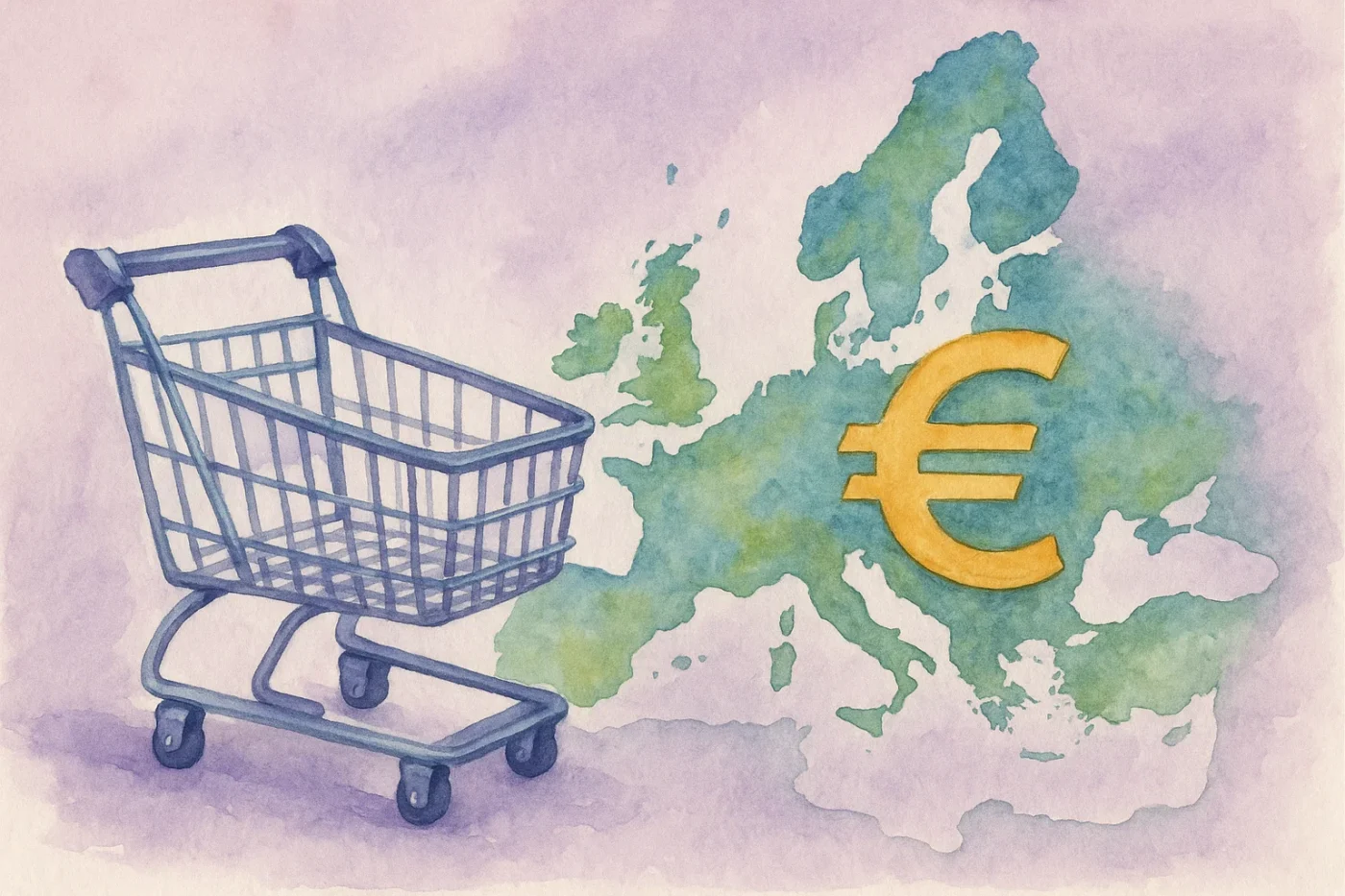Why Europe Is the #1 Growth Opportunity for E-Commerce Brands

In a global e-commerce landscape often dominated by narratives from the U.S. and China, Europe is quietly emerging as the most strategic, and underexploited growth engine for digital brands.
With a market size that rivals global leaders and a consumer base that is both affluent and digitally mature, Europe now represents the most compelling frontier for e-commerce expansion.
Post-pandemic digital adoption, robust logistics infrastructure, and a unified regulatory framework have created ideal conditions for online retailers to scale faster, smarter, and more sustainably across multiple countries.
Add in Europe’s openness to cross-border shopping, rising mobile commerce, and the increasing role of AI and personalization, and it’s clear: e-commerce brands ignoring Europe are leaving serious growth on the table.
Europe stands head-and-shoulders above other regions as the #1 growth opportunity for e-commerce brands looking to expand globally with precision, profitability, and long-term impact.
1. Unrivalled Market Scale & Growth Trajectory
Europe’s Slice of the Global Pie
As of 2025, Europe accounts for over 30% of the global international e-commerce market, according to Cognitive Market Research. In absolute terms, the European e-commerce market is valued at $6 Trillion in 2025 and is projected to grow at a compound annual growth rate (CAGR) of 14.5% through 2031.
This outpaces the growth of other mature regions and puts Europe in a commanding position for global e-commerce leadership.
The numbers tell a clear story: Europe is not a saturated market, it’s an accelerating one, with major growth still ahead, particularly in mobile commerce, digital services, and cross-border trade.
Cross-Border Commerce Powerhouse
One of Europe’s greatest strategic advantages is its openness to cross-border e-commerce. In 2024 alone, Europe’s cross-border e-commerce market reached USD 237.5 billion, with growth expected at a staggering 30.5% CAGR between 2024 and 2031 (source: Cognitive Market Research).
This surge is driven by a consumer base increasingly comfortable with shopping internationally, supported by harmonized regulations and fast, reliable logistics networks.
For brands, this means reaching 27+ markets with a single strategy, and scaling with far fewer operational headaches than in fragmented global regions.
Penetration & Emerging Frontiers
Europe also boasts some of the world’s highest levels of e-commerce adoption.
As of 2024, 77% of internet users across the continent shop online, up from just 59% in 2014. And with 94% of Europeans aged 16–74 using the internet, there’s still room for growth.
While mature markets like Germany, the UK, and the Netherlands lead in volume, emerging economies such as Poland and Italy are among the fastest-growing, offering fertile ground for ambitious brands willing to localize and adapt.
This blend of maturity and potential makes Europe uniquely dynamic among global e-commerce opportunities.
2. Regulatory & Operational Tailwinds
Digital Single Market & Geo-Blocking Ban
One of Europe’s most underappreciated assets for e-commerce brands is its regulatory infrastructure, designed specifically to facilitate cross-border digital commerce at scale.
Through the Digital Single Market (DSM) initiative, the European Union has effectively removed many of the historical barriers to international expansion.
A cornerstone of this effort is the ban on unjustified geo-blocking, which ensures that consumers across the EU can access the same products and services regardless of their country of residence.
For e-commerce brands, this means seamless reach across 27 countries without the need to segment access or content, an operational dream rarely seen in other global markets.
One-Stop-Shop VAT Simplification
In July 2021, the EU introduced the One-Stop-Shop (OSS) VAT system, a major regulatory innovation that simplifies tax compliance across the entire union.
Instead of registering for VAT in each individual country, businesses can now use a single VAT registration to report and remit taxes for all 27 EU member states.
This change has been a game-changer for international e-commerce operations, reducing administrative burdens by up to 95% and freeing up brands to focus on growth, not paperwork.
Harmonized Consumer Rights & GDPR Trust
Europe’s e-Commerce Directive ensures that brands operate under uniform rules and consumer protection standards, giving both businesses and shoppers a level playing field.
This harmonization reduces complexity and cost while also boosting buyer confidence across borders.
Add in GDPR, the world’s most comprehensive data privacy regulation, and Europe offers brands a rare dual advantage: compliance clarity and consumer trust.
While data protection laws in other regions remain inconsistent, GDPR gives European consumers the confidence to share data and engage in personalized commerce, benefiting brands that invest in ethical, transparent practices.
3. Tech-Savvy Consumers & Cutting-Edge Infrastructure
Mobile-First & Payment Diversity
European consumers are not just online, they’re mobile-first and digitally sophisticated.
Mobile devices now account for 55–60% of all e-commerce transactions in Europe, with some markets projected to reach 78% of traffic via mobile by the end of 2025.
Equally important is payment diversity.
Digital wallets have emerged as the top payment method (44%), followed closely by traditional credit/debit cards (42%) and PayPal (32%).
Meanwhile, Buy Now, Pay Later (BNPL) solutions and account-to-account transfers are gaining significant traction, offering multiple levers for conversion optimization at checkout.
Cross-Border Appetite
Europeans don’t just shop locally, they’re active cross-border consumers.
Between 27% and 31% of all online purchases in Europe are made from foreign sellers, showing clear openness to international brands.
Markets like Luxembourg (80%) and Ireland (68.6%) lead in cross-border purchase rates, but the trend spans the continent. This consumer behavior, backed by logistics and regulation, makes Europe an ideal launchpad for borderless e-commerce operations.
Logistics & AI-Driven Innovation
Europe has also invested heavily in its logistics and delivery infrastructure, ensuring e-commerce brands can meet consumer expectations for speed and reliability.
- Germany boasts an average parcel transit time of just 1.19 days
- France follows closely at 1.84 days
- Spain, Netherlands, and others also maintain sub-2.5-day averages
These metrics rival or exceed delivery benchmarks in the U.S. and Asia, offering frictionless fulfillment opportunities across the region.
On the tech front, European retailers are rapidly adopting next-gen retail solutions, including:
- AI-powered personalization engines
- Augmented reality (AR) try-ons
- Computer vision for visual search and inventory
- Internet of Things (IoT) devices for smarter supply chains
For forward-thinking e-commerce brands, Europe isn’t just catching up, it’s setting the pace in applied retail technology.
Conclusion
Europe isn’t just another growth market, it’s the growth market for e-commerce brands in 2025-2026 and beyond.
Its unique combination of market scale, cross-border regulatory harmonization, and cutting-edge infrastructure creates a fertile ground for scalable, sustainable growth.
With over 30% of the global international e-commerce market, 14.5% CAGR through 2031, and a cross-border segment growing at 30.5% CAGR, the numbers speak for themselves.
Scale + Regulation + Savvy Consumers + Tech = Unmatched Growth Runway.
But success in Europe requires more than translation, it demands localization, compliance, mobile-first UX, and a clear sustainability ethos.
Brands that invest in these pillars will find Europe not only accessible but incredibly profitable.
Looking To Integrate Your E-Commerce In Europe?
It can be extremely time-consuming and it will definitely give you tons of headaches if you’re not prepared.
I have something for you, and it’s 100% free.
The EU Integration Checklist 2.0 is a tool meant to help you integrate in your business in Europe much faster.
If you are not sure about selling in Europe… Think about the fact that the E-Commerce Market in the US is worth only $8.3 Trillion, as of 2025. That’s only 30% compared to the Global E-Commerce Market worth $28 Trillion.
In Europe, the E-Commerce Market is worth $6T, projected to reach $18.8 Trillion by 2033.
Take your time!
Click the image below for the link 👇
If you’re looking to learn more about multilingual e-commerce… Here’s a great article for you: How To Get Amazing Results With AI Translation in E-Commerce
Frequently Asked Questions
How can AI turbo-charge my European e-commerce strategy?
AI can supercharge personalization, recommendation engines, and customer service, key expectations among European shoppers.
From AI-powered product discovery to dynamic pricing and inventory forecasting, intelligent automation helps brands stand out while scaling efficiently across multiple EU markets.
Which European markets offer the highest ROI for niche brands?
Beyond the giants (UK, Germany, France), the Netherlands, Sweden, and Austria boast high e-commerce penetration with manageable competition.
Poland and Italy offer rapid growth potential with rising digital adoption, especially for brands that localize well.
What are the key GDPR pitfalls to avoid?
Common missteps include:
- Failing to obtain explicit consent for data processing
- Not offering clear opt-out mechanisms
- Storing user data without adequate encryption or retention policies
- Ignoring cookie compliance across markets
How do VAT OSS and geo-blocking rules simplify expansion?
The One-Stop-Shop (OSS) allows a single VAT registration for all EU countries, saving time, reducing costs, and simplifying tax compliance by up to 95%.
The geo-blocking ban ensures you can sell across the EU without restricting access based on a user’s country, making pan-European campaigns far easier to execute.
What role does sustainability play in European shopper loyalty?
A central one. 66% of European consumers are willing to pay more for sustainable products, and this number is rising.
EU regulations like Extended Producer Responsibility (EPR) and the upcoming Digital Product Passport are pushing brands to adopt circular economy practices.
Those who lead in sustainability gain loyalty and long-term brand equity.






